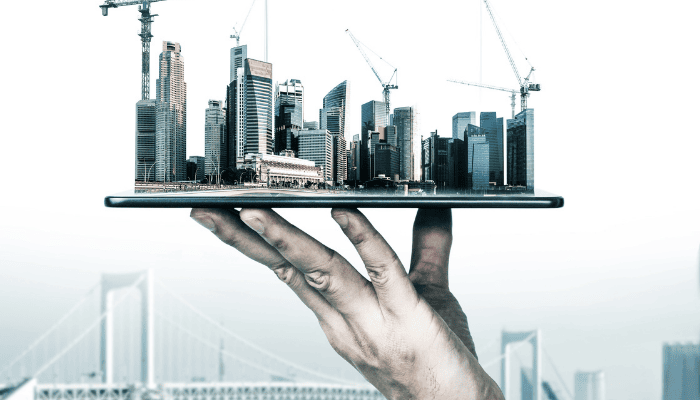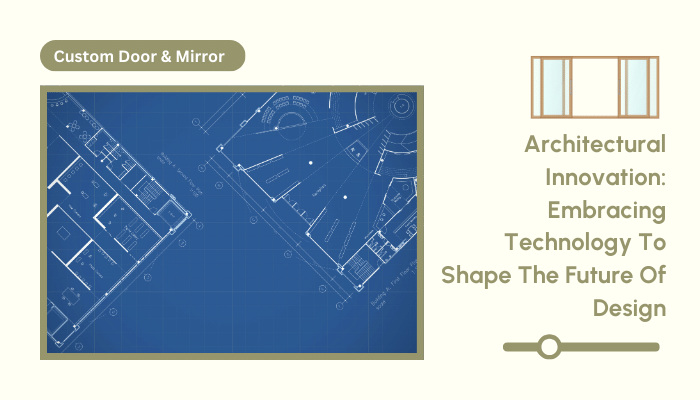Architectural innovation is the reconfiguration of architectural components and design to enhance outcomes, pushing the boundaries of what is possible in the field.
The amalgamation of design, technology, and materials guides this transformative approach, working in harmony to shape the future of architecture.
As technological advancements continue to make leaps and bounds, they have become an integral part of developing innovative architectural solutions.
In today’s rapidly evolving world, architects must embrace these technological advancements to create groundbreaking designs and sustainable built environments.
The integration of cutting-edge tools such as 3D printing, augmented reality, smart building systems, and green building materials empowers architects to create structures that are visually stunning, highly efficient, and environmentally friendly.
Speaking of cutting-edge advancements, let’s dive deeper into how technology is revolutionizing the architecture industry.
The Role of Technology in Architectural Innovation

Technology has become the catalyst for change in the architectural landscape, transforming the way architects conceptualize, design, and construct buildings.
Developing contemporary architectural solutions that meet the demands of a rapidly changing world relies on these technological advancements. Let’s explore some of the key technologies that are driving innovation in architecture:
- 3D Printing: This revolutionary technology enables architects to bring their digital designs to life, creating intricate physical models and even full-scale building components with unparalleled precision and efficiency.
- Augmented Reality (AR) and Virtual Reality (VR): These immersive technologies allow architects to visualize and experience their designs in a fully interactive environment, facilitating better communication with clients and stakeholders and enabling them to make informed decisions.
- Building Information Modeling (BIM): BIM software provides a comprehensive platform for architects to collaborate, manage projects, and optimize building performance throughout the entire lifecycle of a structure, from conception to construction and beyond.
- Smart Building Systems: Smart technologies, such as sensors, automation, and data analytics, enable architects to create buildings that are responsive, energy-efficient, and user-centric, enhancing the overall performance and comfort of the built environment.
- Green Building Materials and Renewable Energy Integration: Architects are increasingly incorporating sustainable materials and renewable energy systems into their designs, minimizing the environmental impact of buildings and promoting a greener future.
- Parametric Design and Responsive Facades: These advanced methodologies allow architects to create adaptive and efficient structures that respond to environmental factors and user needs, optimizing building performance and creating dynamic, ever-changing facades.
By leveraging these technologies, architects can push the boundaries of design, streamline construction processes, and create buildings that are not only aesthetically pleasing but also sustainable and highly functional.
Ready to experience the benefits of custom closet doors? Explore our range of Paniflex products now.
Also Read: The Role Of Architectural Branding In Design
Benefits and Goals of Architectural Innovation
Embracing innovation in architecture offers a wide range of benefits that go beyond mere aesthetics. By harnessing the power of technology, architects can:
- Streamline Construction Processes and Reduce Costs: Innovative technologies help architects optimize building designs, minimize errors, and reduce waste, resulting in faster and more cost-effective construction processes.
- Enhance Customer Satisfaction and Create Competitive Advantages: Incorporating unique design elements and functionalities through the use of advanced technologies allows architects to create buildings that stand out from the competition, attracting clients and enhancing customer satisfaction.
- Promote Sustainability and Eco-Friendliness: Technology enables architects to integrate green building materials, renewable energy systems, and smart building technologies, creating structures that are energy-efficient, environmentally friendly, and contribute to a sustainable future.
To see these benefits in action, let’s check out some inspiring projects that are leading the way in architectural innovation.
Case Studies: Pioneering Examples of Architectural Innovation
To truly appreciate the impact of innovation in architecture, let’s explore some pioneering projects that showcase the seamless integration of technology and design:
- The Edge, Amsterdam: This cutting-edge office building, designed by PLP Architecture, sets a new standard for sustainability and smart building technology. With its intelligent building systems, sensor-equipped workspaces, and energy-efficient design, The Edge exemplifies the future of innovative workplace architecture.
- Masdar City, Abu Dhabi: Designed by Foster + Partners, Masdar City is a groundbreaking sustainable urban development that incorporates renewable energy, water conservation, and intelligent transportation systems, setting a benchmark for eco-friendly urban planning.
- ArchDaily Examples:
- The Morpheus Hotel by Zaha Hadid Architects showcases the integration of advanced engineering and parametric design, resulting in a striking and innovative architectural masterpiece.
- The Fuse Valley by BIG – Bjarke Ingels Group combines sustainable design with innovative building technologies, creating a forward-thinking and environmentally conscious development.
- The Morpheus Hotel by Zaha Hadid Architects showcases the integration of advanced engineering and parametric design, resulting in a striking and innovative architectural masterpiece.
These case studies serve as inspiration for architects worldwide, demonstrating the incredible potential of architectural innovation in creating sustainable, efficient, and captivating built environments.
Of course, groundbreaking projects don’t happen without visionaries behind them—let’s meet the architects who are pushing the envelope.
Ready to experience the benefits of custom closet doors? Explore our range of Paniflex products now.
Innovative Architects and their Impact

Behind every groundbreaking architectural design are visionary architects who dare to push the boundaries of what is possible.
These innovative architects are transforming traditional construction and design paradigms, inspiring a new generation of architects to embrace technology and push the limits of what is possible in the built environment.
Let’s take a closer look at some of the architects and design groups leading the charge in architectural innovation:
- Eric Reinholdt: Founder of 30X40 Design Workshop, Reinholdt is known for his innovative approach to residential architecture, incorporating sustainable design principles and leveraging technology to create efficient and beautiful homes. His work challenges traditional notions of residential design, demonstrating how technology can be used to create more sustainable and livable spaces.
- Jonathan Segal: Segal is renowned for his groundbreaking work in urban infill development, using innovative design strategies and materials to create high-density, mixed-use projects that revitalize urban neighborhoods. His projects showcase how innovative design can transform underutilized spaces and create vibrant, sustainable communities.
- Bjarke Ingels Group (BIG): Led by visionary architect Bjarke Ingels, BIG is at the forefront of architectural innovation, creating iconic projects that blend cutting-edge technology, sustainability, and human-centric design. They challenge traditional notions of architecture, demonstrating how innovative design can create buildings that are not only visually striking but also highly functional and environmentally conscious.
These innovative architects and design groups are pushing the boundaries of traditional architecture, showcasing how technology and innovative design can be used to create buildings that are more sustainable, efficient, and responsive to the needs of the people who inhabit them.
Inspired by these innovators? Wait until you see what’s next—the future trends that are set to reshape architecture as we know it.
Future Trends in Architectural Innovation

As we look towards the future, the role of technology in architecture is set to expand even further. Emerging technologies and trends that are poised to shape the future of architectural innovation include:
- Nanotechnology and New Materials: The development of advanced materials at the nanoscale level, such as self-healing concrete and carbon nanotubes, will enable architects to create structures with unprecedented strength, durability, and functionality. These materials will revolutionize the way buildings are constructed, allowing for more efficient and sustainable structures.
- Artificial Intelligence and Robotics: The integration of AI and robotics in the design and construction process will revolutionize the way buildings are created. AI-powered design tools will enable architects to generate and optimize building designs in ways that were previously unimaginable, while robotics will allow for faster, more precise, and safer construction methods. The combination of AI and robotics has the potential to transform the entire building lifecycle, from design to construction and beyond.
- Expectations for Architectural Innovation in 2024/2025: In the coming years, we can expect to see an increased focus on sustainable design, the integration of smart building technologies, and the adoption of immersive design tools like AR and VR. Buildings will become more energy-efficient, with the widespread use of renewable energy systems and green building materials. Smart building technologies will enable buildings to adapt to the needs of their occupants, creating more comfortable and productive environments. Architects will use immersive design tools to create more engaging and interactive experiences for clients and stakeholders, facilitating better communication and collaboration throughout the design process.
The future looks bright, but how do we ensure that innovation keeps flourishing? Let’s explore the culture that makes it all possible.
Ready to experience the benefits of custom closet doors? Explore our range of Paniflex products now.
Cultivating a Culture of Innovation in Architecture
To fully embrace innovation in architecture, it is crucial to foster a culture that encourages collaboration, experimentation, and continuous learning.
Architects must actively seek out opportunities to collaborate with professionals from diverse disciplines, such as designers, technologists, and engineers, to bring fresh perspectives and innovative ideas to the table.
And the more expertise you have, the more you can contribute.
Moreover, the architectural community must prioritize the adoption of new technologies and sustainable practices, investing in training and education to ensure that architects are equipped with the skills and knowledge needed to leverage these tools effectively. Architects must be willing to experiment with new ideas and technologies, embracing a culture of continuous learning and improvement.
Architectural firms and educational institutions must also play a role in cultivating a culture of innovation. They can include funding for innovative projects, workshops and seminars on emerging technologies, and partnerships with technology companies and research institutions.
Finally, let’s tie it all together and reflect on how embracing a culture of innovation can transform the future of architecture.
Conclusion: Reflecting on the Future of Architectural Innovation
As we reflect on the transformative power of technology in architecture, it becomes clear that innovation is not merely a trend, but a fundamental shift in the way we design and build.
Embracing cutting-edge technologies and sustainable practices gives architects the opportunity to create buildings that are not only visually stunning but also highly efficient, environmentally friendly, and deeply attuned to the needs of the people who inhabit them.
The future of architecture is one where innovation and sustainability go hand in hand, shaping the cities and buildings of tomorrow. We can expect to see buildings that are more energy-efficient, with the widespread use of renewable energy systems and green building materials.
Smart building technologies will enable buildings to adapt to the needs of their occupants, creating more comfortable and productive environments.
Immersive design tools will allow architects to create more engaging and interactive experiences for clients and stakeholders, facilitating better communication and collaboration throughout the design process.
As architects continue to push the boundaries of what is possible, we can look forward to a future where the built environment is more resilient, adaptable, and responsive to the ever-changing needs of society. The impact of these innovations will be felt not only in the buildings we create but also in the communities we serve, as architecture becomes a catalyst for positive change and social progress.
So, let us embrace the power of architectural innovation, harness the potential of technology, and work together to build a future that is not only beautiful but also sustainable and inclusive. The possibilities are endless, and the impact of our innovations will be felt for generations to come.






